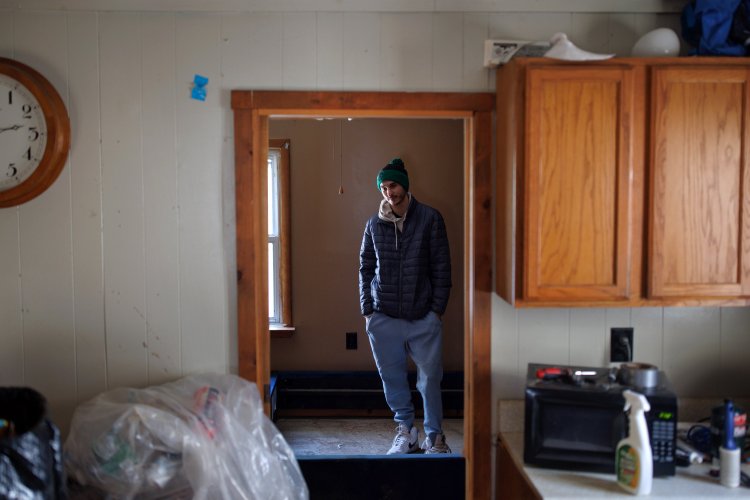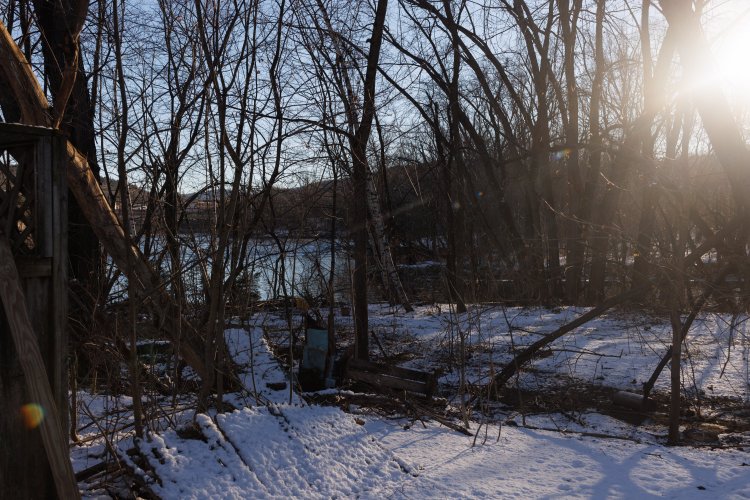Teddy McLaughlin stands outside the house he rents in Mexico, which was flooded during the December 18 rainstorm. His furniture, destroyed by the flood, is stacked in piles on the front lawn. McLaughlin is in the process of moving into a new apartment. Brianna Soukup/Photographer
Teddy McLaughlin knew he would never be able to carry his two large dogs through the waist-deep frigid water that jumped the banks of the Swift and Androscoggin Rivers and flooded Dix Street in Mexico.
So McLaughlin sat in the house he’d been renting for a year — a house he hoped to buy soon — and watched the water rise, seeping out of the overflowing basement and flowing through vents as he waited for the fire department. To rescue him and his dogs Beau and Bear.
Although he got out safely, many of his possessions were destroyed by the disastrous December 18 storm, destroyed by torrential rains.He spent all his money cleaning the place up and keeping the generator and propane heaters running.
McLaughlin, 27, hasn’t given much thought to renter’s insurance, let alone flood insurance. Apparently the property owner doesn’t have flood insurance either, so he doesn’t know how they are going to replace the missing front porch, appliances, and hot water heater or prevent mold from growing. ‘
He doesn’t plan to stay to find out.
“I thought I finally had a place, somewhere I was going to put down roots, maybe start a family, and then bam,” he said. “Now (the owner) can’t pay me $100 to take the place.”
McLaughlin’s case is not unique. Maine has a surprisingly low flood insurance rate — less than 1% by some estimates. Nationally, the rate is about 4%, according to the Federal Emergency Management Agency. As climate change progresses, experts say there will likely be more extreme weather events like what happened last month that left McLaughlin and thousands of other Maine residents stranded. A moderate snow storm this weekend, which is expected to be followed by heavy rain mid-week, may increase the risk of flooding in some areas.
However, even as flooding has become a greater concern across the state, officials say the number of people purchasing flood insurance has declined in the past decade.
Some people assume, incorrectly, that they can only get coverage if they live in an area at risk of flooding, however Flood insurance is available to any property owner or renter located in a community participating in the National Flood Insurance Program. In Maine, all but 22 communities participate.
Many homeowners and renters also mistakenly believe they are covered by regular home insurance, but most policies do not cover water damage. Homeowners can purchase an endorsement for their regular home insurance that covers backup water from sump pumps and sewage, but not flood water coming from doors, windows or foundations. Some companies have an exception where if the power goes out and the submersible pump doesn’t work, it’s still not covered.

Teddy McLaughlin stands Tuesday in the bedroom of his rented house in Mexico, which was flooded by a December rainstorm. Brianna Soukup/Staff Photographer
Many owners say that the additional policy is very expensive. Often times, they think they will never need it.
“Flood insurance is very difficult to sell to the general public,” said Diane Champoux, president of Champoux Insurance in Lewiston. “You never think you’re going to experience flooding unless you’re right on the river or in an area that’s considered high risk. Mainers seem to feel like it won’t happen to them.
But FEMA estimates that about 25% of all claims come from areas not considered high risk. Experts warn that as the planet warms, the frequency and ferocity of storms will increase — and that could be bad news for Maine.
The National Climate Assessment’s Interactive Atlas Explorer projects sharp increases in heavy rainfall in parts of Maine in extreme warming scenarios. In one scenario, Aroostook County would see an 83% jump in heavy rain days, the largest of any U.S. county. The federal government’s National Flood Insurance Program covers about 12% to 14% of annual flood damage in the United States, putting millions at financial risk.
Extreme rainfall events and subsequent flooding can cause a variety of costly problems, including property damage, lost tourism days, sewer overflows that pollute drinking water and private wells, and closure of oyster beds. In its 2020 report “The Cost of Doing Nothing,” the Maine Climate Council estimated that climate-related flooding caused by overflowing rivers and streams could cause up to $2.4 billion in total building losses and wipe out another $2.6 billion in jobs annually.
Maine has about 7,240 policies under the National Flood Insurance Program. But that number has been declining for years, according to Sue Baker, state coordinator for Maine’s floodplain management program, even as extreme weather spreads.
This trend worries insurance professionals like Chamboux.
“It’s definitely a coverage that’s going to be more and more necessary because … other than fire, water damage is probably the most expensive repair done to a structure. It’s got to be done right or you’re going to have mold issues,” Shambaugh said. homes) have to be willing to pay those extra dollars.”
On average, a Maine insurance policy costs about $1,306 a year, according to FEMA data, and that’s on top of a traditional home insurance policy.
For some, that number may soon rise.
FEMA recently revised its risk rating system so that each person’s policy is based on individual structure, rather than the more static approach used since the 1970s, which did not include as many flood variables. The changing model means that while some people will see their rates fall, others, especially those who received subsidized rates because their homes were built before flood risk maps were introduced in the 1970s, will see an increase. Often those older homes were not built with flood protection in mind. The new system has gradually eliminated subsidized premiums. FEMA estimates that about two-thirds of policies are not at full risk rating.

Slime from floodwaters remains in Teddy McLaughlin’s bedroom in Mexico. Brianna Soukup/Staff Photographer
In Maine, which has a long coastline and the nation’s oldest housing stock, FEMA expects the average insurance premium will increase incrementally each year until it reaches an average of $2,700. Rates cannot exceed 18% annually.
This may be an unwelcome surprise for many, especially new homebuyers. Additionally, Maine is among 16 states that do not require flood hazard disclosure.
“If someone is buying a property, no one is required to tell them that the building is in a flood risk area. It’s up to the buyer to do their homework,” Baker said. “The reality is that many people don’t do their due diligence to find out before closing on the property. If so, they often don’t find out until they go to a lender for financing.
There is a bill in the state Legislature that would require flood risk disclosure, but its fate is uncertain.
Even for people with flood insurance, there are still risks.
For coverage to take effect, the water must cover at least two acres of land that is normally dry or it must damage at least two properties, including yours, in the immediate area. So, if your house is lower than your neighbors’, leaving you flooded while they’re completely dry, you’re out of luck.
“There’s a gap between flood insurance and your property insurance, where even if you have water, there’s no insurance coverage available to purchase,” Shambaugh said. “Water is a risk that is difficult to insure against.”
Casey Hines decided against flood insurance when he opened Cushnoc Brewing Company in Augusta seven years ago. The brewery and pizza shop is located just steps from the Kennebec River, but Hines, co-owner and general manager, said it wouldn’t have made any sense economically.
“It’s a complete scam,” Haynes said. “It’s expensive, there’s a high deductible, there’s a lot that’s not covered, and after a flood event like this, your premiums will go up.
“This is not something we plan to do, even after this disaster,” he added.
Hines watched the river he looked at every day turn into what he described as an “inland ocean” in a matter of hours. the The brewery’s downstairs event space was flooded with about 8 feet of water and is in “complete ruin.”
While the cleanup and renovation will be expensive — Hines said it will likely involve “five zeros” — demolition is underway and he hopes to have the space back up and running within the next few weeks.

A view of the Androscoggin River from Teddy McLaughlin’s backyard in Mexico on Tuesday. Brianna Soukup/Staff Photographer
The state has already requested relief from the Federal Emergency Management Agency, members of which arrived in Maine this week to assess damage from the storm. It’s the first official step toward requesting a major disaster declaration from the federal government, which would unlock a pool of additional money and resources. Any money from FEMA will likely go toward infrastructure repairs, although some businesses may benefit.
On the other hand, homeowners won’t.
Dick and Shirley Pike, from Naples, managed to escape last month’s flood unharmed. Their only casualty from the storm was a broken snow blower, which Dick Pike said is good news because now he can replace it. The Pikes don’t have flood insurance, but the fifth-wheeler they call home is on slightly higher ground, so while the water was “biting away” at their door, nothing seeped inside. On the other hand, their way is another way. story.
Pikes hopes some federal money will be allocated for Crooked Way repairs.
“It took a beating,” Dick Pike said.
“Ex
Maine may require property sellers to disclose flood risks
the next ”
Related stories

Username/password is incorrect.
Please check your email to confirm and complete your registration.
Use the form below to reset your password. When you submit your account email, we will send you an email with a reset code.